Go from Macaron Mess to Macaron Success following these macaron tips for beginners that I’ve learned over my many macaron baking attempts.
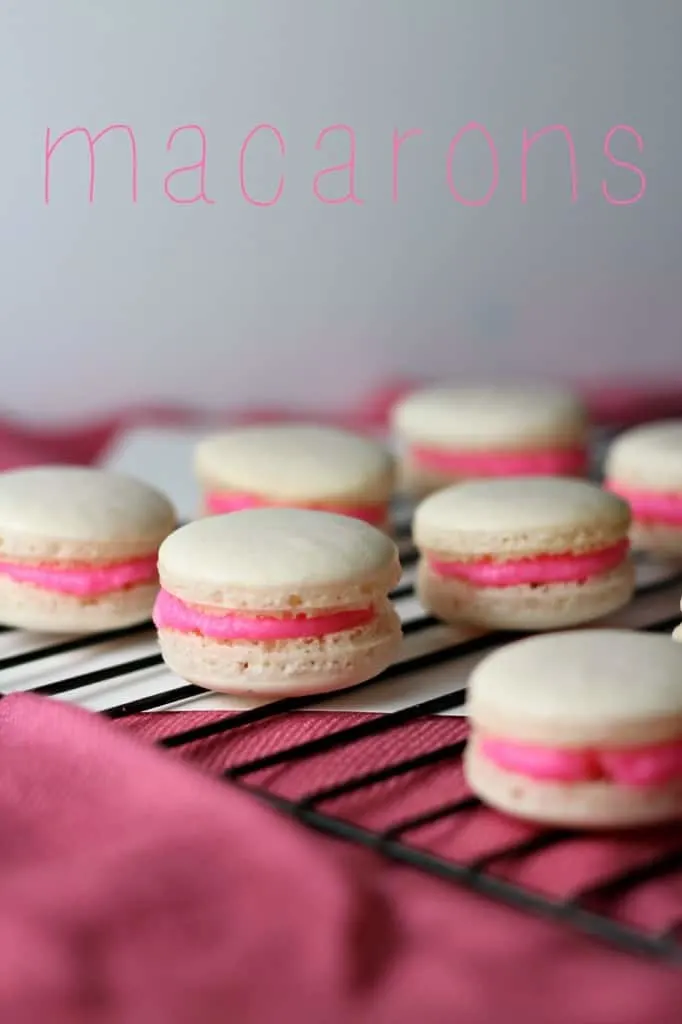
Macaron tips for beginners
How to make macarons is a much talked about topic in the world of fine baking. I don’t live in a fine baking world. I live in the world of “see dessert”, “learn to make dessert”, and “eat dessert”.
Can you relate? Do you want to learn how to make macarons at home?
Macaron tips for beginners is a good place to start when you want to achieve homemade lovely macarons. Such a simple idea: two meringue cookies sandwiched with a creamy filling.
I associate macarons with French baking but I’ve learned that the cookie may have an Italian history. This European delight has grown in popularity in the United States and it can be found in many bakeries yet most Americans don’t whip up a batch of macarons in the way we might do so with chocolate chip cookies. Why not?
Well, there is much to be said about the process of making macarons and so many questions create doubt for the home baker. I am THAT home baker– the one wondering if I have half a chance at macaron success. I am also the home baker who would like to master macarons.
I plan to try a few different techniques and recipes then I’ll share what works and what doesn’t. Won’t you bake along with me with these macaron tips for beginners?
What ingredients are in macarons?
- ground almonds,
- confectioners’ sugar,
- egg whites
- and granulated sugar.
As an Amazon Associate I earn from qualifying purchases.
Are macarons gluten free?
Macaron shells are naturally gluten free. Often fillings for macarons like lemon curd, pumpkin butter, raspberry jam, buttercream, nutella are also gluten free.
You do need to take caution, though, if you purchase macarons to read the ingredient list because often manufacturers add gluten to their fillings where you wouldn’t expect it. For example, boxed macarons at Costco are not gluten free.
Is making macarons difficult?
The process of making macarons is not difficult but it takes a period of trial and error to grow your confidence and ability. My boys are taking ice skating lessons and the instructor told the kids (loud enough for the parents to get the message too) that you must not be afraid to fall down. It is part of learning.
Baking is the same– there will be batches of burnt cookies, lopsided cakes and cracked macarons on your way to kitchen confidence but keep going!
I made macarons about a year ago without much trouble. Beginners’ luck for sure.
When I recently thought I’d repeat that performance I was greeted by batch of macarons that spread over the entire baking sheet into one, sad-looking blob. I turned to Google to see what might help my next attempt.
Here’s what I found as I’m learning how to make macarons:
History: there are many websites with macaron history but I like this playful list of 10 Beautiful Facts about Macarons from Huff Post UK.
Many chefs have their own ideas about macarons. Stella, author of the blog BraveTart, has an excellent collection of tips, myths, and recipe.
This macaron recipe from the Bouchon Bakery is another great place to start.
Pinterest: Pinterest has a nearly endless supply of macaron photos, recipes, ideas, colors, and flavors. If you would like to join my Pinterest board for all things macaron send me a request and I’ll add you. I’d love to have a place where we can share ideas and our latest creations! Here is the link to the new board.
Books: Start at your local library or find books like this one on Amazon: Les Petits Macarons
The macarons pictured were made with Stella’s recipe. I felt much better about these sweet macarons than I did about the blob of disaster above and these tips can help you grow in the same confidence. Let’s start with just a few tips so we are not overwhelmed:
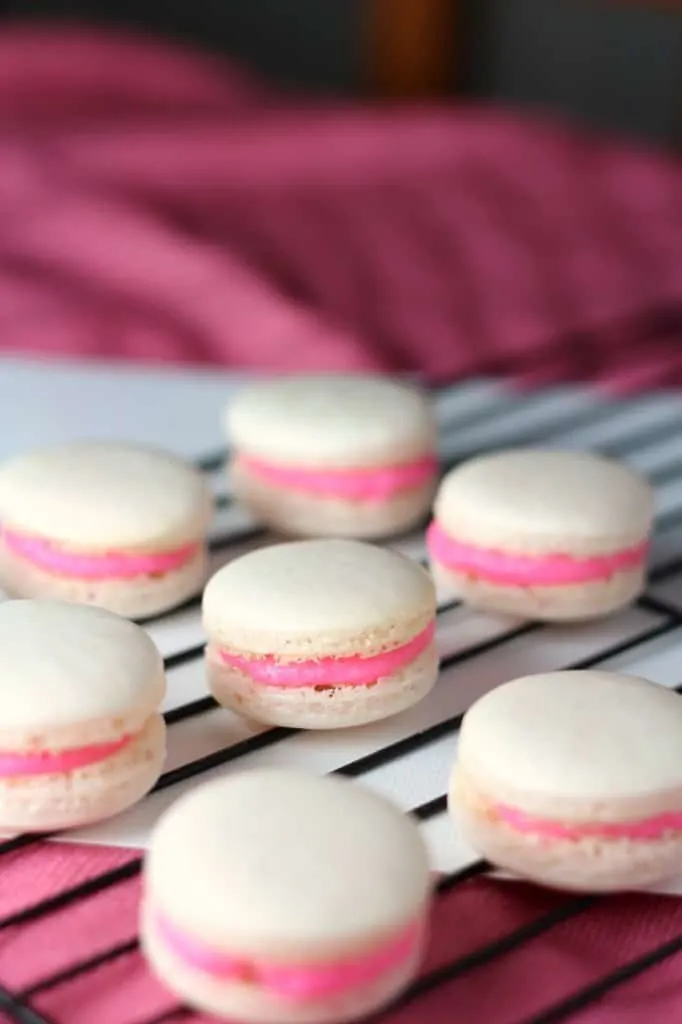
- use a kitchen scale to weigh your ingredients
- I was severely under-whipping the egg whites. Don’t be afraid to make a very stiff and dry meringue. This can take more than 10 minutes with a stand mixer
- instead of grinding your own almonds, take the shortcut and begin with almond flour. I use Bob’s Red Mill Super Fine Almond Flour
- for beginners like me, it helps to use a macaron baking sheet. SO HELPFUL! These silicon sheets provide a consistent size and also give a touch of stability to your meringues that parchment paper cannot. Look at the difference between the SAME batter which was piped and baked — one on parchment and one on the macaron baking sheet. I had over mixed the batter but the baking sheet gave me a better chance of success.
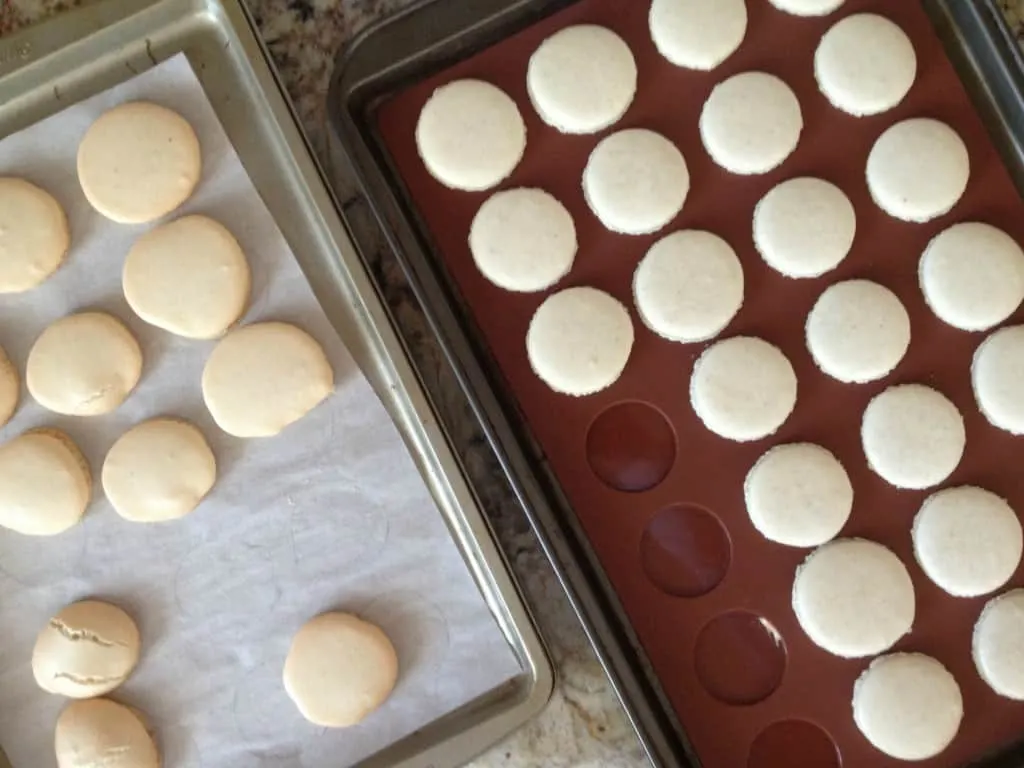
The one tool that helps me make beautiful macarons: the macaron baking mat
The baking tool I find most helpful when learning how to make macarons is a Macaron Baking Mat. The mat has circular indentations that make crafting identical macarons SO MUCH EASIER. When I’ve experimented with that same batch of macaron batter and made one tray with my molded baking mat and the other tray without the mat, I’ve had much better results with the mat.
The molds give the macarons structure and, for me, are an insurance policy for when I may have under mixed my batter. Instead of spreading all over a regular baking mat, my macarons puff up, develop that signature foot around the edge, and bake beautifully.
How to pipe macarons without a macaron baking mat
Before I found the macaron mat (which honestly is the easiest way to pipe macarons), I would trace circles on my parchment which would guide me in making consistently sized macaron shells. Each time I’d trace around a circle cookie cutter or something else that was about the right size in my kitchen. The method worked but was time consuming.
Here’s a better solution in making uniform macaron shells: a printed template filled with circles. I created exactly this template and share it with you in my Free Printables Library. Access is free to my email subscribers.
We are a participant in the Amazon Services LLC Associates Program, an affiliate advertising program designed to provide a means for us to earn fees by linking to Amazon.com and affiliated sites.
Ok, let’s get baking! I hope you’ll share you macaron success stories with me on Instagram at @abakershouse. You can do it!
Here are some of my favorite variations. What’s your favorite?
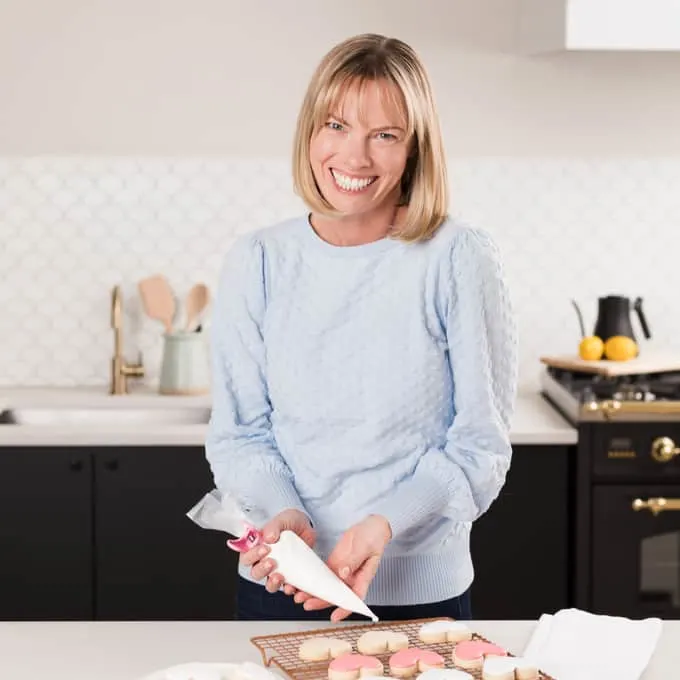
Holly Baker started the food blog, A Baker’s House, in 2011. She is the writer, recipe creator, and photographer for the site. Holly loves to bake and shares recipes for gluten free food, canning recipes, as well as traditional desserts too. Her recipes and food photography have been highlighted by BuzzFeed, Reader’s Digest, and She Knows.

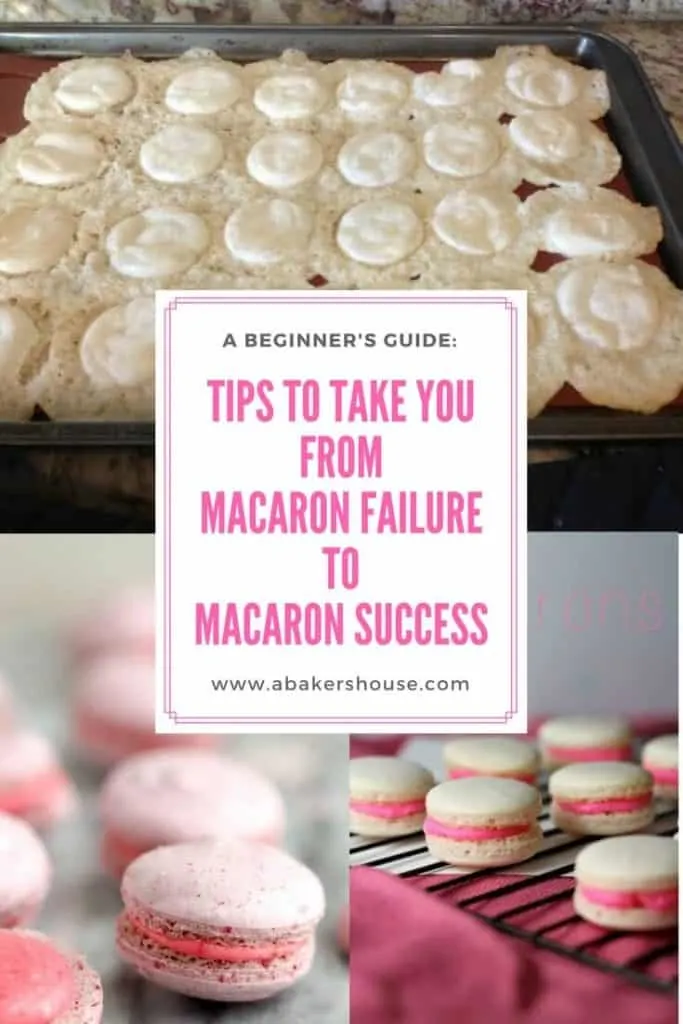
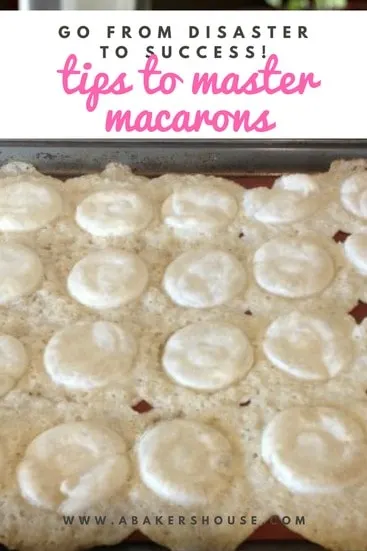
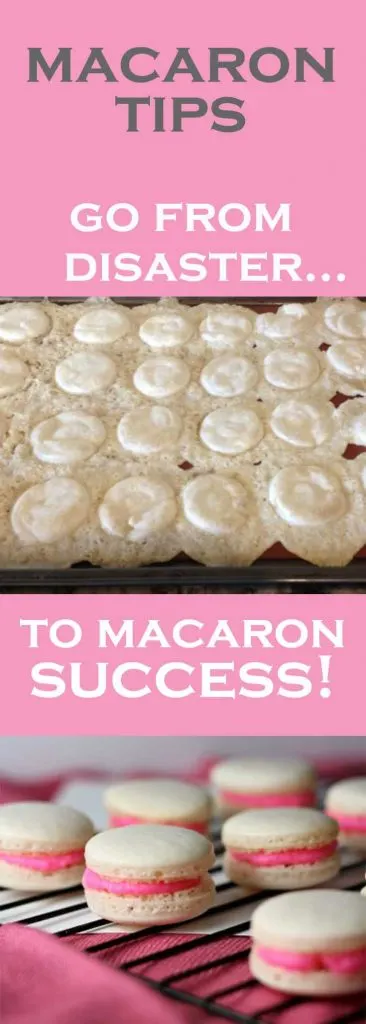
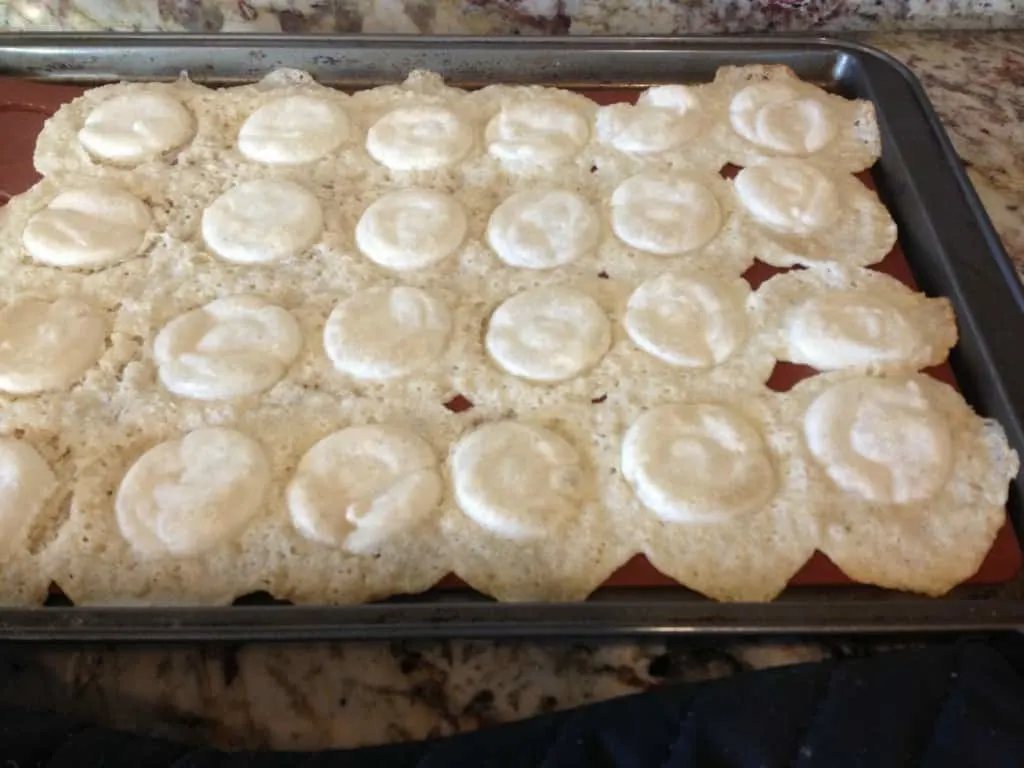
sapna
Sunday 24th of November 2019
how to substitute egg white with flaxseed gel??i m a vegetarian n i wish to try macarons..pls help
Holly Baker
Sunday 24th of November 2019
You'll want to google a recipe for macaroons made with aquafaba, the liquid from chickpeas. I haven't made them myself but am curious to see how they would turn out. I don't know if substituting with flaxseed gel would work in a typical macaron recipe.
Ann C Kellum
Tuesday 2nd of July 2019
My niece and I made our first batch of macarons. today. They looked beautiful, had the requisite feet and held up nicely but were a bit hollow. We live in Florida where there's a lot of humidity. Could that be the problem? Or did we over beat/under beat the eggs?
I would appreciate your feedback.
Holly Baker
Thursday 4th of July 2019
It sounds like you are so close to perfection with your macarons! It's hard for me to say what went wrong but it might be the humidity. You can try to change just one thing each time. You could let the macarons rest a bit longer before baking or you could whip the egg whites for less time. It is a tricky balance and can change due to weather and other conditions.
Naheed
Saturday 13th of April 2019
My macrons have wrinkles when i bake them.....dont know why?
Holly Baker
Saturday 13th of April 2019
Macarons can be tricky and frustrating! It's hard to say why your macarons have wrinkles. Did you let the tops dry out before baking? Perhaps you could change the amount of time you let the skin form on the top of the unbaked macarons and try again. It is definitely a process getting it all to work out right!
Judy Semro
Wednesday 10th of April 2019
My daughter and I have tried 3 different recipes and all ended in the blob you mentioned. The first batch, we didn't beat the egg whites long enough. The second batch we under mixed the batter The 3rd batch, the egg whites were stiff and batter was perfect, or so we thought. We used a silicone pad and watched them turn into a blob. What are we doing wrong.
Holly Baker
Thursday 11th of April 2019
Oh goodness, macarons sure can be frustrating! I love that you have given them a few tries. Let's try to troubleshoot: what is your oven temperature? Use an oven thermometer to make sure that the actual temp is the same as what you've set. Often ovens can be 10-20 degrees off which throws off macarons. What is the weather? Humid, dry? Macarons behave differently depending on the conditions. Are you using cream of tartar? It helps stabilize the egg white and might help you avoid that dreaded blog. Is your silicone pad a macaron mat or just a silicone flat sheet? I've had success with the silicone macaron mat (the one with individual circles for each macaron) which gives the macarons that added bit of structure.
Karen Nichols
Monday 16th of July 2018
Since I have never eaten a macaron I’m not sure exactly what they are like except the pictures are so pretty. Are they supposed to be hollow? With a bit of a crunchy top?
Holly Baker
Tuesday 17th of July 2018
Hi Karen, I hope you give macarons a try. It can be helpful to eat one from a bakery or even from a box before baking these for the first time. I like the versions offered in the frozen section at Trader Joe's. Costco sells frozen macarons too. They defrost easily. A macaron should have a domed top that isn't particularly crunchy but it is well baked. The inside should be soft-- not hollow-- and even a little chewy. The filling can add to the soft texture in the middle-- think buttercream, nutella, or jam. Enjoy!